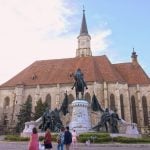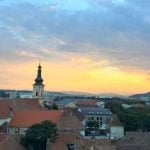Just a short drive outside Cluj-Napoca in the Transylvania region of Romania, the Hoia-Baciu Forest has many nicknames, including Romania’s Bermuda Triangle, and the most-haunted forest in the world. Why? Over the years there have been thousands of reports about paranormal activity here, including UFOs, ghosts, and disappearances. Whether you’re looking for the supernatural or just an interesting hike, we recommend visiting Romania’s Haunted Hoia Baciu Forest.

Separating fact from fiction in the Hoia Baciu Forest
The Hoia Baciu Forest takes its name from a local shepherd who disappeared in the forest with his flock of sheep. Over the years, locals who have ventured into the forest have returned with strange tales as well as physical symptoms including burns and rashes. Since the 1960s there have been numerous sighting of UFOs here, many of which have been captured on film. The most common reports include seeing balls of light, as well as ghosts, or hearing voices and giggling.

One story tells of a five-year old girl who went into the forest and came back out five years later, wearing the same clothes and not looking a day older. There are some 1,000 people who are thought to have disappeared here over the years.
The strange activity in the forest centers around a clearing where nothing grows. While scientists have studied the soil and determined that there’s nothing wrong with it, the area is devoid of plant life. Some claim it is a portal to another world.
Researchers have come from around the world to study the forest, and numerous magazines and newspapers have included it in their lists of the world’s most haunted places. It is a fascinating and unique place to hike.

Visiting Cluj-Napoca
The Hoia Baciu Forest really is special. But there’s plenty to do in Transylvania and there’s much more to the region than Dracula and haunted forests. This is one of the most interesting and beautiful regions in Romania. We highly recommend visiting Cluj-Napoca, the city nearest to the Hoia Baciu Forest.
Cluj-Napoca is the spiritual and economic capital of Transylvania. There are numerous important hospitals and universities here. This is a place where the past, the present and the future come together. With fine dining, excellent cultural activities, a wonderful historical legacy and a welcoming atmosphere, the city will certainly not disappoint those who add it to their travel itinerary.
Cluj-Napoca: The cultural heart of Romania
Bohemian cafes, music festivals and wild nightlife are the soul of Cluj-Napoca. The city traces its origins back to the Dacian settlement of Napuca in the 2nd century A.D. The name Cluj comes from Castrum Clus, first used in the 12th century as the name of the citadel surrounding the city. Clus means “closed” in Latin and refers to the hills that surround the city. German merchants, who arrived here in the 12th century, rebuilt the medieval earthen walls of Cluj with stone after the Tartar invasion of 1241.The nickname “treasure city” was acquired in the late 16th century, and refers to the wealth amassed by residents, including in the precious metals trade. Cluj became Cluj-Napoca in the 1970s, when the communist regime added the name of the old Roman settlement to emphasize the city’s Daco-Roman origin.
Cluj-Napoca’s main square, resplendent with 18th and 19th century buildings and home to many shops and restaurants, is dominated by the 15th century St. Michael’s Church. This is one of the finest examples of Gothic architecture in Romania. The square also hosts the 18th century baroque Banffy Palace, as well as the Romanian art collections of the Art Museum. Visitors who want to learn more about the region should pay a visit to the open-air section of the Ethnographic Museum of Transylvania, a true display of folk architecture. For entertainment, spend an evening at the opera or attend a classical music concert offered by the Cluj Philharmonic.
Traveling to Romania
Romania is a wonderful destination for travel, though many westerners still associate it with the dictator Nicolae Ceausescu. He came to power in 1965, and decades of oppression followed. He was finally overthrown and executed in 1989. Romania joined the European Union in 2007. It has not yet changed to the Euro. Romania uses the Romanian Leu (RON). Prices for food and drink are a real bargain compared to Eurozone countries. Rates at hotels have been creeping up and are similar to those in Central European destinations. So it’s not quite the cheap vacation that out-of-date guidebooks lead you to expect. But you can still have a great time on a budget. Although a full EU member, Romania is not part of the Schengen Area. Border checks are still in place. They’re most noticeable if you enter or leave the country by road.
Are you planning a trip to Romania? We’re Romania travel experts. We’d love to help you book a customized tour. Just get in touch to start planning!
Photos courtesy of:

Stephan Delbos is an internationally published writer and editor. Born in the US, he has lived, worked and traveled in Europe for a decade. He’s fond of oysters and arid martinis.


